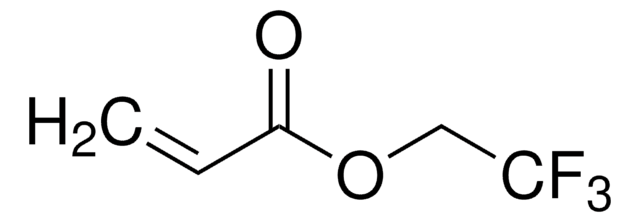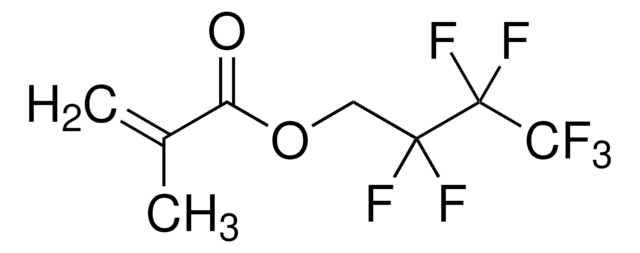474487
1H,1H,2H,2H-Perfluorodecyl acrylate
contains 100 ppm tert-butylcatechol as inhibitor, 97%
Synonym(s):
3,3,4,4,5,5,6,6,7,7,8,8,9,9,10,10,10-Heptadecafluorodecyl acrylate, 1H,1H,2H,2H-Perfluorodecyl acrylate
About This Item
Recommended Products
Assay
97%
contains
100 ppm tert-butylcatechol as inhibitor
refractive index
n20/D 1.337 (lit.)
bp
90 °C/4 mmHg (lit.)
density
1.637 g/mL at 25 °C (lit.)
storage temp.
2-8°C
SMILES string
FC(F)(F)C(F)(F)C(F)(F)C(F)(F)C(F)(F)C(F)(F)C(F)(F)C(F)(F)CCOC(=O)C=C
InChI
1S/C13H7F17O2/c1-2-5(31)32-4-3-6(14,15)7(16,17)8(18,19)9(20,21)10(22,23)11(24,25)12(26,27)13(28,29)30/h2H,1,3-4H2
InChI key
QUKRIOLKOHUUBM-UHFFFAOYSA-N
Looking for similar products? Visit Product Comparison Guide
General description
Application
- As a monomer to synthesize block copolymer brushes of the [2-(methacryloyloxy)ethyl] trimethylammonium chloride (PMETAC) and poly(1H, 1H, 2H, 2H-perfluorodecyl Acrylate) (PPFDA). These polymer brushes can be used to reduce friction in microfluidic and biomedical devices.
- To prepare fluorinated block copolymers via chemical vapor deposition(CVD). These are highly transparent and hydrophobic films utilized as biocompatible coatings on optical glasses and commercial optical filters.
- As a precursor to synthesize poly(1H, 1H, 2H, 2H-perfluorodecyl acrylate) nanoparticles which can used as drug carriers and have the ability to cross the blood-brain barrier(BBB). They are utilized for the targeted transport of neuroprotective agents.
- To fabricate anti-fouling and anti-infective surface coating for medical textiles.
Signal Word
Danger
Hazard Statements
Precautionary Statements
Hazard Classifications
Acute Tox. 4 Inhalation - Acute Tox. 4 Oral - Carc. 2 - Eye Dam. 1 - Lact. - Repr. 1B - STOT RE 1
Target Organs
Liver
Storage Class Code
6.1C - Combustible acute toxic Cat.3 / toxic compounds or compounds which causing chronic effects
WGK
WGK 3
Flash Point(F)
235.4 °F - closed cup
Flash Point(C)
113 °C - closed cup
Personal Protective Equipment
Certificates of Analysis (COA)
Search for Certificates of Analysis (COA) by entering the products Lot/Batch Number. Lot and Batch Numbers can be found on a product’s label following the words ‘Lot’ or ‘Batch’.
Already Own This Product?
Find documentation for the products that you have recently purchased in the Document Library.
Customers Also Viewed
Our team of scientists has experience in all areas of research including Life Science, Material Science, Chemical Synthesis, Chromatography, Analytical and many others.
Contact Technical Service













